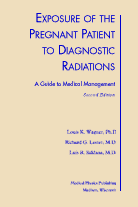
Exposure of the Pregnant Patient to Diagnostic Radiations
Author: Louis Wagner et alISBN: 9780944838723 ISBN10: 0944838723
Published: 1997 | 259 pp |
OUT OF PRINT
Health Physics | September 1998
"This book was written for the physician to provide guidance in dealing with and counseling patients who are pregnant at the time they need or have received diagnostic examinations involving exposure to radiation. Both ionizing and non-ionizing radiation sources are included. The book consists of eleven chapters and three appendices. The book is divided into three parts.
"Part I contains the first four chapters and is devoted to elementary radiobiology and the physics of diagnostic radiations from x rays, nuclear medicine procedures, ultrasound, and MRI. A review of the mechanisms by which radiation interacts and the relative amounts reaching the conceptus from various examinations is included. The discussion on the effects of radiation to cells and to the conceptus as a whole is brief, but well written. A discussion of the radiation units is included along with a table showing how to convert from SI units to conventional units. Chapter 3 reviews the amount of radiation absorbed by the conceptus from various routine x-ray examinations and lists the factors that must be considered when attempting to calculate the dose. The same thing is done for nuclear medicine procedures and includes useful tables for conceptus doses from both x rays and radiopharmaceuticals. Chapter 4 deals with prenatal risks and does an exceptional job of discussing risks in terms of the percent likelihood of NOT developing childhood cancer rather than the usual approach. I much appreciated the openess with which the authors discussed the dose effects, the limits of certainty/uncertainty in the data, and the studies that suggest a conservative approach.
"Part II is devoted to the management of pregnant patients who need radiological evaluations. This part contains lists of points to consider in counseling the patient and in obtaining a reasonable estimate of the dose to the conceptus. Included are sample forms to be used in collecting data for estimating and reporting the dose. There is also a review of the '10-day rule' and the uncertainty of determining whether or not a patient is pregnant. Guidance is presented for making decisions to proceed or not to proceed with certain studies even when it is known that the patient is pregnant. The advisability of and risks associated with substitution of non-ionizing radiation procedures is covered in this part.
"Part III deals with the clinical evaluation of pregnant patients who have been exposed to diagnostic radiations. Included here are points to consider in counseling the patient, guidelines for obtaining reasonable estimates of the dose and recommendations regarding radiation and abortion. Chapter 11 contains 23 case reports of patients who received diagnostic examinations while they were pregnant. The dose estimates, counseling given, and the outcomes make for interesting reading.
"Appendix A provides useful formulas, figures, and tables that can be used to estimate the dose from diagnostic x-ray examinations.
"Appendix B does the same thing for radionuclide studies while Appendix C provides a list of physical half-lives of radionuclides used in nuclear medicine procedures.
"Overall, I found this to be a very easy-to-read book that contains a great
deal of useful information about radiation and pregnancy. Although it is
written for physicians, it would be a useful reference for medical physicists,
medical health physicists, or anyone who has to deal with the concept of
radiation and pregnancy. In particular, it should be required reading for
all radiology residents."
Kenneth L. Miller, Penn State University, Hershey Medical Center, Hershey, PA 17033


